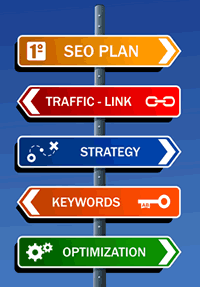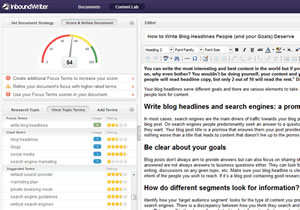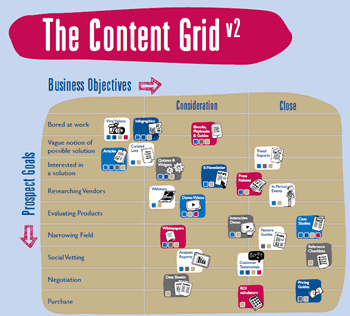 If you’re serious about your content marketing strategy and processes, you need content marketing software. In the strict sense, content marketing software is enterprise content marketing technology software that enables you and your team to collaborate and plan/deploy/monitor/optimize your content marketing strategy in a professional and optimized way, delivered via the cloud.
If you’re serious about your content marketing strategy and processes, you need content marketing software. In the strict sense, content marketing software is enterprise content marketing technology software that enables you and your team to collaborate and plan/deploy/monitor/optimize your content marketing strategy in a professional and optimized way, delivered via the cloud.
This often happens in connection with other (marketing) platforms, such as marketing automation software, CRM, content management systems (CMS), touchpoint mapping and social tools. Sometimes these are included in the content marketing software or, at least, some features are.
On this page we look at some of the main types of content marketing software, especially in a B2B marketing perspective, although consumer brands can benefit as well.
Do you need content marketing software?
The answer is very easy: if you want to do it well and have a single customer view that enables you to better reach and convince your customers before, during and after the buy, you’ll certainly need one that integrates with other platforms.
While processes and internal buy-in and engagement are key, content marketing software is a must to optimize your efforts as I explain further. Many businesses use specific, smaller content marketing software platforms with less features than enterprise-level solutions of very specific features and that’s perfectly OK if it works and if your business is not ready or not equiped for a full-fledged content marketing strategy. This is also often done in initial stages when the business is starting to deploy a content marketing strategy.
Content marketing software can improve the efficiency of your content marketing efforts a lot, depending on how you are able to use them. Collaboration will only work if the process is easy and clear, and contributors actually do use the platforms to collaborate. Technology is an enabler.

In the infographic below by Kapost (one of the enterprise-level vendors), based on research by Aberdeen Group, you’ll notice some of these effects when using enterprise content marketing platforms. They shouldn’t surprise as – when properly used – these tools indeed help you to plan and optimize better. In an entirely different category of platforms, focused on content optimization, a test of InboundWriter by Jay Baer and Bryan Eisenberg showed a clear impact as well.
However, the biggest gains regarding results will come from (and after) internal engagement, processes, buy-in and changes. No software can help you do that. If a vendor or his partner can support you anyway, then maybe that’s a bonus to take into account.
Regardless of all the research: the right tools when properly used are simply crucial. To succeed you need to optimize. To optimize you need process and tools. Obviously, you need to analyze the ROI before investing. Don’t only look at the benefits on the short term however and make sure you take into account indirect costs. The software investment is part of the whole equation.
A mix of content marketing software and other business tools
Ideally and depending on your context, a mix and integration of your content marketing software with essential other business tools is advised.
This includes, on top of the content marketing software, itself:
- Marketing automation (or email marketing) platform. No marketing automation or lead generation without content and – in most cases – vice versa.
- Customer Relationship Management (sometimes a marketing automation platform or MAP can be used for that and most MAPs can be integrated with CRM tools anyway).
- Social media listening, monitoring, publishing and analysis tools (most also offer social publishing possibilities but so do enterprise level content marketing software platforms).
- Content management system. Most professional content marketing software supports popular CMS applications and nearly all support blogging platforms such as WordPress that are increasingly used as full-fledged content management systems.
- Others. Publishers will use other platforms as well (that we won’t mention as we mainly look at marketing), for instance to make the link with print, mobile or management of multiple media and brands. Other possible integrations: customer service and customer experience management tools, collaboration/intranet software, project management, social business tools, social CRM, big data analytics, etc. (more in the list of potential features below).
How to build your content marketing software toolbox
It’s important to choose the proper platform as getting the wrong content marketing software (or any other marketing platform) can make your life harder instead of easier. Note that, although some enterprise-level platforms virtually cover all stages of the content marketing process, this doesn’t mean they are the best choice for you.
Sometimes it might – depending on context and budgets, among many others – be better to select several content marketing platforms that each have their own specific “tasks” and connect them with each other and other applications. That’s what the cloud enables you to do.
Some things to look at before choosing your ideal content marketing software toolset:
- How far are you in your content marketing strategy exercise? If your goals are not fully defined yet, you don’t have all the content you need to achieve them or don’t have the proper structure and processes in place, then it might be better to use some easy tools with limited features first. Strategy first, tools later. There are several content marketing software applications that have limited features you can use in the earlier stages such as content sourcing, editorial planning and more. The good news is that most work with a pay-as-you-go model so when you’re ready to take the next step you can always stop and get a software that’s better suited. Some will say not to get any content marketing software at all in early stages but why would you not use what you can already use to improve efficiency of what you already can do? Content marketing is about change and you can’t expect that everyone in the organization will change overnight.
- Your installed base of marketing software matters as well. It’s clear that if you already have a CMS, marketing automation software, social media publishing and monitoring tool, etc. you better take a look at potential integration costs. Maybe there’s a solution that has the integrations you need. Talk with different vendors of the platforms you already use, hire a consultant, involve IT, etc. Make sure you are ready for potential hidden costs when the actual integration happens.
- Ease-of-use. I can’t stress the importance of this enough. Even if your content marketing team and processes are perfect and everyone in the organization is dying to collaborate and act as one content/marketing/customer team, you get nowhere if the platform is hard to use. All those nicely engaged employees will disengage if they find the software too difficult or the way you use it too ‘heavy’. Even if the will to collaborate as a business is there (and that’s another story), easy execution and actual collaboration matter.

The content grid by Eloqua as mentioned in the Aberdeen Group “The Content Shop” - The traditional selection criteria. If you ever had to buy a marketing software for your business, you probably know some of the main things to look at. Obviously, they apply to content marketing software as well. Just a few suggestions, as a reminder:
- Ask for testimonials, talk to peers and try to get in touch with existing user of the platform. And of course use content, after all that’s part of the reasons why we use content marketing during the vendor research stage (as mentioned in the content grid image on the right).
- Start from the needs you have to fulfill your goals, not from the features.
- Do the math: your CFO wants to know more than the actual price of the software. Total Cost of Ownership, required resources, expected output, hidden costs, the whole thing. Forecast ROI.
- Make sure you know how much training will be needed, how support works, etc. (also see costs).
- The proof of the pudding is in the eating. Test and try software, compare, get input from all stakeholders. In content marketing there are many (departmental) stakeholders so involve them too.
- Check if there’s a partner ecosystem and what it can offer. This especially goes for enterprise-level content marketing software. On top of consultancy or implementation partnerships the vendor can also work with vendors of other, related, marketing software. This can be a good sign.
- Check out the vendor from different angles. Although in this ‘cloud’ age a change of vendor can sometimes happen fast when something ‘bad’ happens to one, you don’t want to invest too much expensive resources in a vendor with an unstable position.
This list is certainly not exhaustive, feel free to add more.
Content marketing software in the broad sense
In the very broad sense, content marketing software is all software that is used to create, curate, track, share and source content, often in combination with SEO. And that’s how many vendors use it. The majority of software platforms and content marketplaces describing themselves as content marketing software, focus on one or more of the following functions, that are really just a piece of the professional content marketing puzzle.
These features can be (a combination of):
- Content sourcing and aggregation.
- Keyword and competitor analysis.
- Internal collaboration and collaboration with external partners (such as external content producers). In this regard it’s important to look at how your network is set up and see how easy the software and your IT team can make that external collaboration happen.
- Storage of ideas and suggestions for later discussion.
- Content marketing or buyer persona definition and matching.
- Content gap analysis.
- Data support and integration.
- (Native) advertising.
- Video content features.
- Budget and ROI management.
- Support of different content formats.
- Content personalization or dynamic content (typically done in combination with marketing automation).
- SEO, device and content optimization.
- Social content, social sharing and social optimization.
- Corporate blogging and content production.
- Content curation.
- Mobile and multichannel optimization.
- Content distribution.
- Content workflows, blog workflows, etc.
- Analytics.
- Offline marketing/publishing.
- Editorial calendars, typically more advanced than those you can use for your blog.
This is already a first basis for classification (on top of the ‘real’ enterprise content marketing software tools).
However, it’s not THE classification. The overuse of the term ‘content marketing software’ as we see it now might confuse potential buyers. However, as content marketing is so ‘hot’ I understand it. But if you go too broad, it makes no sense anymore. Imagine that tomorrow WordPress starts calling itself a ‘content marketing software’ (and in fact, it might one day soon) tomorrow.
But you know how search engines work: they don’t classify or take into account definitions and it doesn’t make life easier for people searching. It becomes even more complex if you know that some tools, such as content curation platforms, are again divided into different subcategories: professional, consumer, B2B, different goals and usage formats, etc.
Content marketing is also about more than just SEO or social media but it’s true that nowadays the growing attention for content marketing in these areas and thus the increasing use of the term content marketing software for tools that are mainly about SEO, sharing, inbound, etc. is quite dominant.


